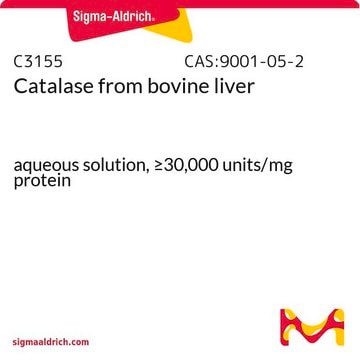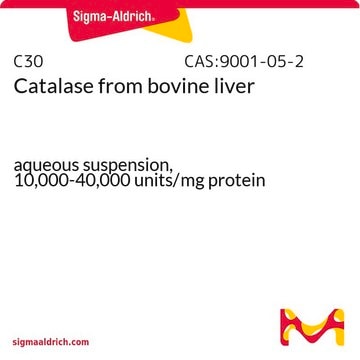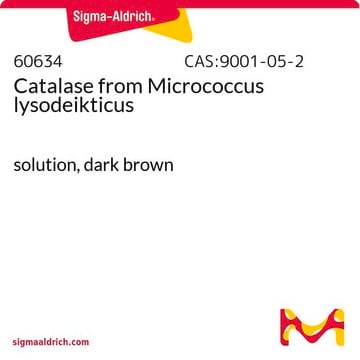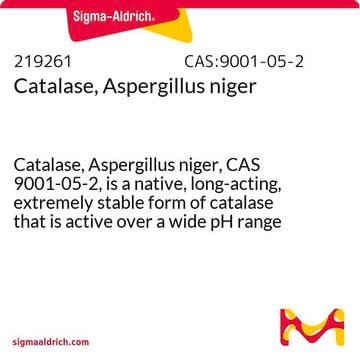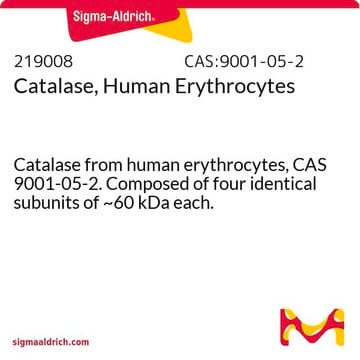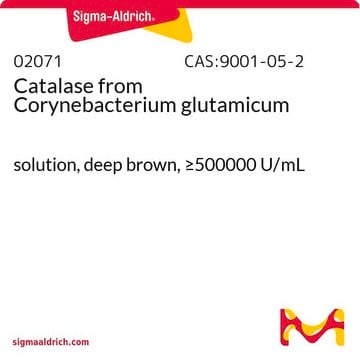E3289
Catalase from bovine liver
≥20000 units/mg protein, lyophilized powder
Synonyme(s) :
H2O2:H2O2 oxidoreductase
About This Item
Produits recommandés
Forme
lyophilized powder
Activité spécifique
≥20000 units/mg protein
Poids mol.
tetramer ~250 kDa
Composition
protein, ≥60% E405
Point isoélectrique
5.4
Conditions d'expédition
wet ice
Température de stockage
−20°C
InChI
1S/C9H10O3/c1-2-12-9(11)7-3-5-8(10)6-4-7/h3-6,10H,2H2,1H3
Clé InChI
NUVBSKCKDOMJSU-UHFFFAOYSA-N
Vous recherchez des produits similaires ? Visite Guide de comparaison des produits
Description générale
Catalase is encoded by the gene mapped to human chromosome 11p13. Mammalian catalase is an antioxidant enzyme and is a member of hydroperoxidase family). The active enzyme is homotetrameric in nature.
Catalase from bovine liver is a tetramer consisting of 4 equal subunits each with a 60 kDa molecular weight. Each of these subunits contains iron bound to a protoheme IX group. The enzyme will also strongly bind to NADP, where NADP and the heme group are within 13.7 angstroms.
Application
- as a component of gloxy, which is one of the most popular oxygen-scavenging systems.
- in single molecule fluorescence resonance energy transfer (FRET) measurements.
- in cytochrome-C oxidase (COX) histochemistry to study the role of mitochondrial uncoupling protein 2 (UCP2) in limiting oxidative stress during glaucoma.
- to pre-treat slide chambers for total internal reflection fluorescence (TIRF) microscopy.
- in quantifying hydrogen peroxide release.
- to help minimize the effects of reactive oxygen species (ROS) in cooperativity assay for studying doublecortin and microtubule interaction.
Catalase from bovine liver may be used:
- to prepare H2O2-O2 based biocathode for applications in glucose biofuel cells
- to study the kinetic properties and storage stability of catalase immobilized on to florisil
- in glutathione-mediated superoxide generation in an aqueous solution
Actions biochimiques/physiologiques
Définition de l'unité
Forme physique
Mention d'avertissement
Danger
Mentions de danger
Conseils de prudence
Classification des risques
Resp. Sens. 1
Code de la classe de stockage
11 - Combustible Solids
Classe de danger pour l'eau (WGK)
WGK 1
Point d'éclair (°F)
Not applicable
Point d'éclair (°C)
Not applicable
Certificats d'analyse (COA)
Recherchez un Certificats d'analyse (COA) en saisissant le numéro de lot du produit. Les numéros de lot figurent sur l'étiquette du produit après les mots "Lot" ou "Batch".
Déjà en possession de ce produit ?
Retrouvez la documentation relative aux produits que vous avez récemment achetés dans la Bibliothèque de documents.
Les clients ont également consulté
Notre équipe de scientifiques dispose d'une expérience dans tous les secteurs de la recherche, notamment en sciences de la vie, science des matériaux, synthèse chimique, chromatographie, analyse et dans de nombreux autres domaines..
Contacter notre Service technique

